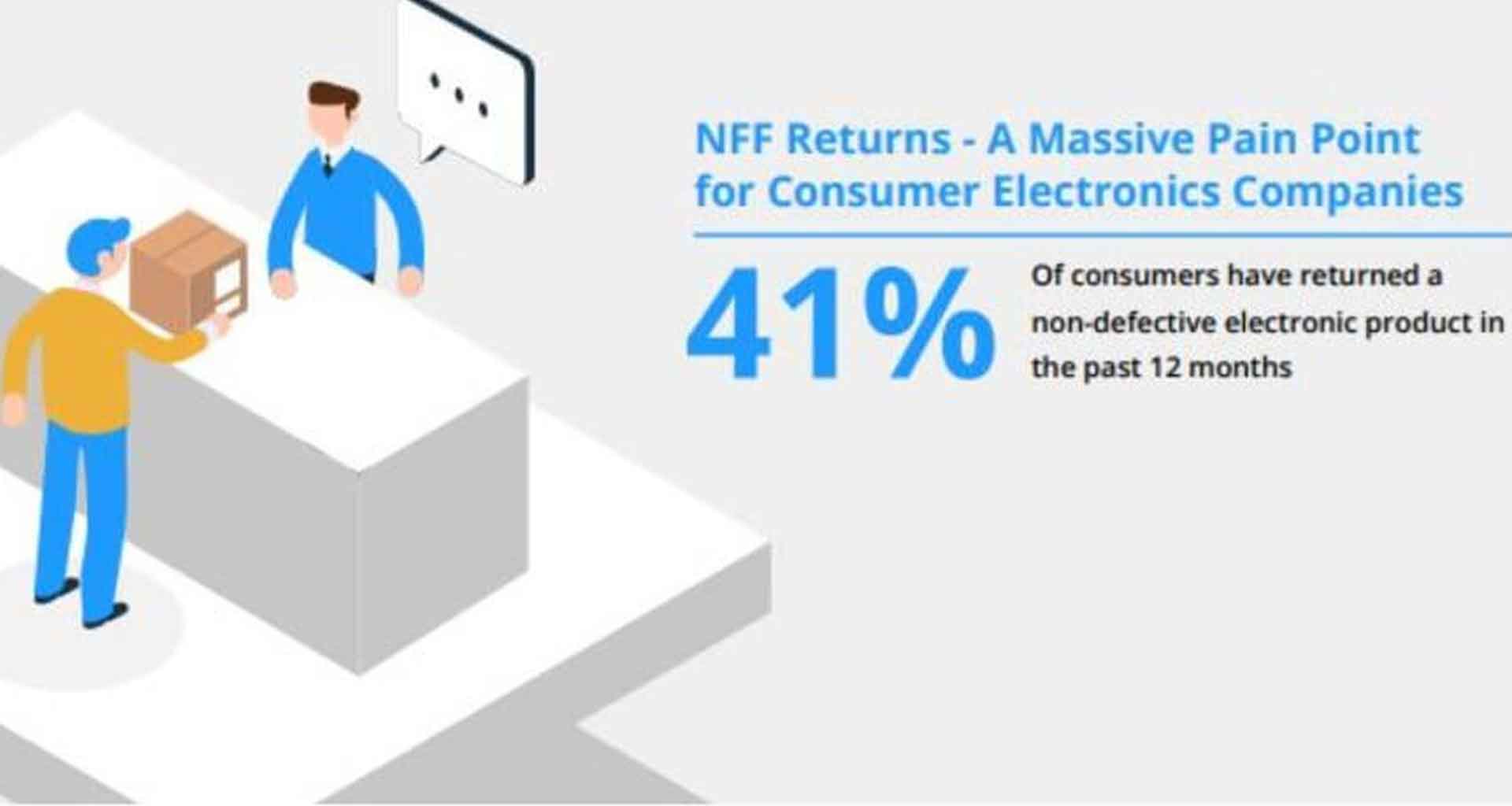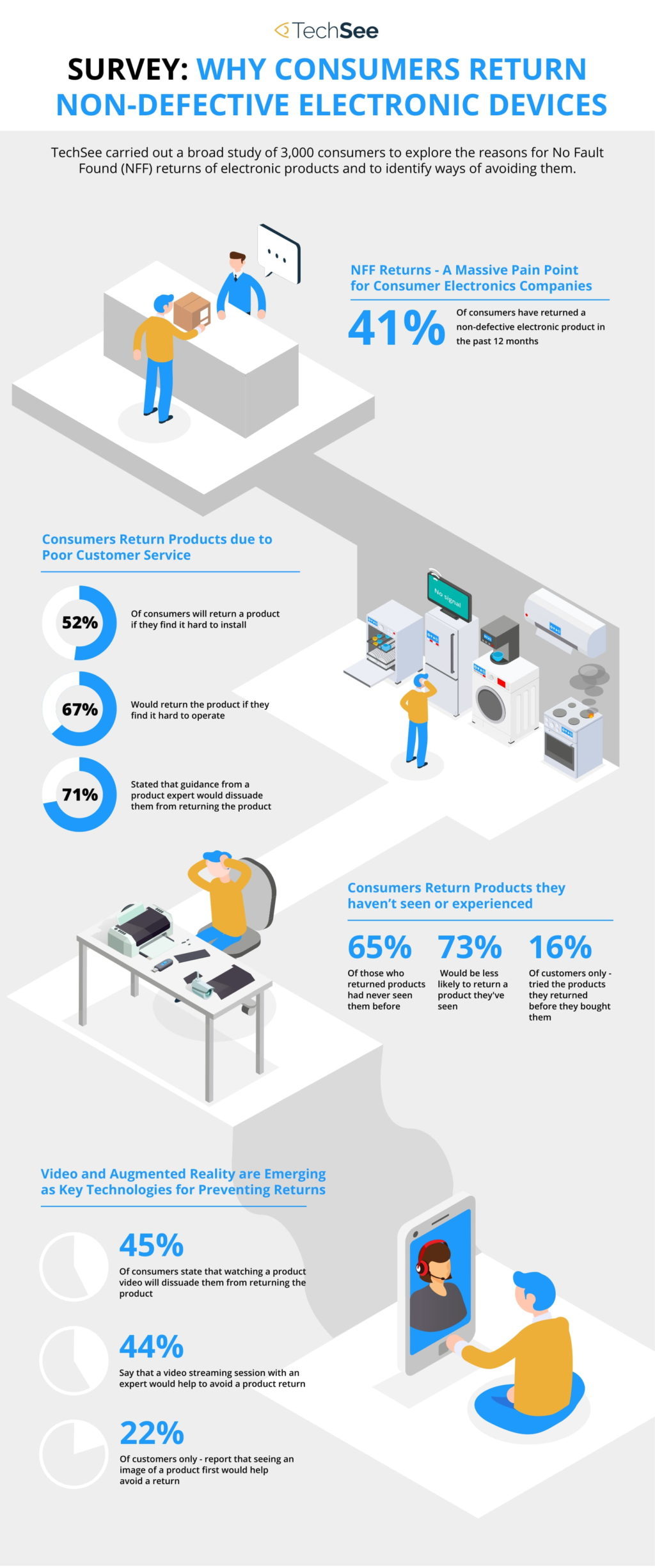Contents
- What is NFF?
- Why Is Consumer Electronics Return Rate So High?
- How Much Do Returns Cost Retailers?
- When Do Consumers Decide to Return Items?
- Consumer Electronics Return Rates: The Real Numbers
- NFF Retail Returns Are Rampant
- Consumer Electronics Survey Reveal the Need for Customer Service
- How Visual Experiences Are Vital to Reducing Returns
- Product Videos vs Visual Assistance – Which is Better to Reduce Returns?
TechSee, a global leader in visual customer assistance powered by AI and Augmented Reality, has released the results of a study on consumer returns in the retail industry. The study focuses on consumer behavior when returning non-defective electronic devices, revealing some eye-opening findings.
TechSee polled more than 3,000 U.S. consumers for the census-weighted study about retail returns. They interviewed men and women aged 18 to 60 of varying incomes, education levels, and geographic locations to find out information about consumer electronics return rates.
This infographic presents the survey results at a glance. For a complete report, you can download our NFF Survey results here.
Lets take a step back and provide definition and context before we dive into insights generated from our survey stats.
What is NFF?
NFF is the term used to describe No Fault Found product returns. An NFF return is when a customer returns a non-defective product to the company it bought it from.
Why Is Consumer Electronics Return Rate So High?
More consumers than ever are sending back fully functioning electronic products. This No Fault Found phenomenon in retail returns is costing companies a fortune.
Explore the following case studies to gain an understanding behind the high consumer electronics return rate.
Case Study 1
Sara Turner was looking forward to receiving her new espresso machine. But when she opened the box, she was confused and dismayed to see that the machine was different than expected – there was no milk frother. She checked her order and realized that the online image of a delicious, frothy cappuccino was for illustration purposes only.
Sigh.
No coffee today.
Case Study 2
Her husband Mike was just as excited to open his package. He was looking forward to saving money with his new smart thermostat. However, he immediately felt overwhelmed by the multi-step installation instructions.
He called customer services, who repeated the same instructions he’d just read in the manual – and he still couldn’t make heads or tails of them.
Oh well.
Back to the store.
How Much Do Returns Cost Retailers?
The survey demonstrates that 41 percent of us have returned a non-defective item in the past 12 months. Global professional service consultants estimate that such returns account for more than $17 billion in lost annual revenues for brick-and-mortar and online retailers.
When Do Consumers Decide to Return Items?
The study also revealed that 65 percent of respondents decided to return non-defective electronics early on, citing frustration or confusion during:
- product unboxing
- installation
- first use
Consumer Electronics Return Rates: The Real Numbers
Consumers most often returned small home appliances, such as:
- blenders and coffee machines (28.5 percent)
- entertainment products, including speakers, TVs, and gaming consoles (25.2 percent)
- small gadgets (20.3 percent)
- phones and tablets (15 percent)
- major appliances such as washing machines and refrigerators (5.7 percent)
- home office products (4.8 percent)
NFF Retail Returns Are Rampant
The prevalence of consumer electronics returns of non-defective devices represents a massive pain point for brands and retailers. An Accenture reporting back in 2011 states that 68% of all consumer electronics returns fall under the umbrella of No Fault Found (NFF), situations when an item is returned despite functioning properly.
Consumer Electronics Survey Reveal the Need for Customer Service
54% of consumers agreed that they would return a product if they found it difficult to install, while nearly 70% said they would also return it if they found it hard to operate. This suggests that customer support is a critical component in lowering NFF consumer returns in the retail industry.
72 percent of those polled stated that good customer service would dissuade them from returning a product. This underscores that more positive unboxing and customer service experiences – both immediately post-purchase and on an ongoing basis – have the power to influence whether the device will be returned.
How Visual Experiences Are Vital to Reducing Returns
Many participants with a propensity to return products also stated they had never seen or interacted with a product they’d returned – physically or virtually (via video or augmented reality) – prior to purchasing. Only 16% claimed they’d had the ability to “try before they buy.”
When seeing or interacting live with a product is not possible or convenient, video has emerged as an effective alternative. With the right features and capabilities, video can offer users a more engaging and interactive experience.
Using video can reduce the consumer electronics return rates and improve the customer experience during:
- initial setup
- configuration
- troubleshooting
- regular maintenance
This short video demonstrates how this is possible.
45% of consumers state that watching a product video will dissuade them from returning a product and 44% say the same for a live video streaming session with an expert.
Product Videos vs Visual Assistance – Which is Better to Reduce Returns?
Visual Assistance powered by augmented reality (AR) can make the unboxing, installation and activation process even more intuitive by delivering a new level of visual customer assistance. This technology is considered more effective than product videos, as it is more personalized and applies to the customer’s actual environment. It incorporates interactive feedback and the ability to correct the customer when needed.
Gartner had predicted that by 2020, 85% of consumers would manage their brand interactions without the input of a human agent. As a result, advanced customer self-service solutions – such as AI-driven mobile visual guidance – are more important than ever.







